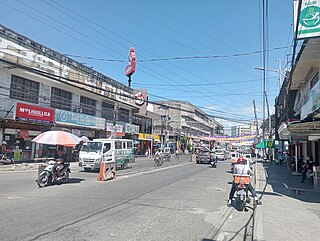
Basco, officially the Municipality of Basco, is a 5th class municipality and capital of the province of Batanes, Philippines. In the 2020 census, it had a population of 9,517 people.

Navotas, officially the City of Navotas, is a 1st class highly urbanized city in the National Capital Region of the Philippines. According to the 2020 census, it has a population of 247,543 people.
Elections in the Philippines are of several types. The president, vice-president, and the senators are elected for a six-year term, while the members of the House of Representatives, governors, vice-governors, members of the Sangguniang Panlalawigan, mayors, vice-mayors, members of the Sangguniang Panlungsod/members of the Sangguniang Bayan, barangay officials, and the members of the Sangguniang Kabataan are elected to serve for a three-year term.

Dulag, officially the Municipality of Dulag, is a 3rd class municipality in the province of Leyte, Philippines. According to the 2020 census, it has a population of 48,992 people.

Cabatuan, officially the Municipality of Cabatuan, is a 3rd class municipality in the province of Isabela, Philippines. According to the 2020 census, it has a population of 39,990 people.

San Agustin, officially the Municipality of San Agustin, is a 3rd class municipality in the province of Isabela, Philippines. According to the 2020 census, it has a population of 22,096 people.

Santo Tomas, officially the Municipality of Santo Tomas, is a 4th class municipality in the province of Isabela, Philippines. According to the 2020 census, it has a population of 24,528 people.

Alfonso Castañeda, officially the Municipality of Alfonso Castañeda, is a 1st class municipality in the province of Nueva Vizcaya, Philippines. According to the 2020 census, it has a population of 8,539 people, making it the least populated municipality in the province.

Daet, officially the Municipality of Daet, is a 1st class municipality and capital of the province of Camarines Norte, Philippines. According to the 2020 census, it has a population of 111,700 people.

Calatrava, officially the Municipality of Calatrava, is a 5th class municipality in the province of Romblon, Philippines. According to the 2020 census, it has a population of 11,342 people.

Romblon, officially the Municipality of Romblon, is a 3rd class municipality and capital of the province of Romblon, Philippines. According to the 2020 census, it has a population of 40,554 people. The archipelagic municipality is the capital of the province of Romblon and the seat of its provincial government. It includes Romblon Island as well as the nearby islands of Lugbon, Alad and Cobrador.

Rizal, officially the Municipality of Rizal is a 2nd class municipality in the province of Nueva Ecija, Philippines. According to the 2020 census, it has a population of 70,196 people.
The Philippines is divided into four levels of administrative divisions, with the lower three being defined in the Local Government Code of 1991 as local government units (LGUs). They are, from the highest to the lowest:
- Regions are mostly used to organize national services. Of the 17 regions, only one—the Bangsamoro Autonomous Region in Muslim Mindanao—has an elected government to which the central government has devolved competencies.
- Provinces, independent cities, and one independent municipality (Pateros)
- Component cities and municipalities within a province
- Barangays within a city or municipality

The gobernadorcillo was a municipal judge or governor in the Philippines during the Spanish colonial period, who carried out in a town the combined charges or responsibilities of leadership, economic, and judicial administration. The gobernadorcillo was the leader of a town or pueblo. In a coastal town, the gobernadorcillo functioned as a port captain. They were appointed through an exclusive nomination provided by the Spanish law. Their term of office lasted for two years.

Catbalogan, officially the City of Catbalogan, is a 5th class component city and capital city of the province of Samar, Philippines. According to the 2020 census, it has a population of 106,440 people.
A barangay captain, or a barangay chairman, is the highest elected official in a barangay, the smallest level of administrative divisions of the Philippines. Sitios and puroks are sub-divisions of barangays, but their leadership is not elected. As of March 2022, there are 42,046 barangays and therefore 42,046 barangay captains.
In the Philippines, local government is divided into three levels: provinces and independent cities, component cities and municipalities, and barangays, all of which are collectively known as local government units (LGUs). In some areas, above provinces and independent chartered cities are autonomous regions, such as the Bangsamoro Autonomous Region in Muslim Mindanao. Some towns and cities remit their revenue to national government and is returned through the national government through a process called internal revenue allotment. Below barangays in some cities and municipalities are sitios and puroks. All of these, with the exception of sitios and puroks, elect their own executives and legislatures. Sitios and puroks are often but not necessarily led by an elected barangay councilor.

The Liga ng mga Barangay sa Pilipinas and the Asosasyon ng mga Kapitan ng Barangay are formal organizations of all the barangays in the Philippines. Presently, almost 42,000 barangays are part of this organization, making it the association of Philippine local government units with the largest membership.
Local elections were held in the Philippines on May 13, 2013, the same day and on the same ballot as national elections. Elected were governors, mayors and council members of Philippine provinces, Philippine cities and Philippine municipalities. Separate elections for barangay officials were held on October.
Metro Manila, the capital region of the Philippines, is a large metropolitan area that has several levels of subdivisions. Administratively, the region is divided into seventeen primary local government units with their own separate elected mayors and councils who are coordinated by the Metropolitan Manila Development Authority, a national government agency headed by a chairperson directly appointed by the Philippine president. The cities and municipality that form the region's local government units are further divided into several barangays or villages which are headed by an elected barangay captain and barangay council.














